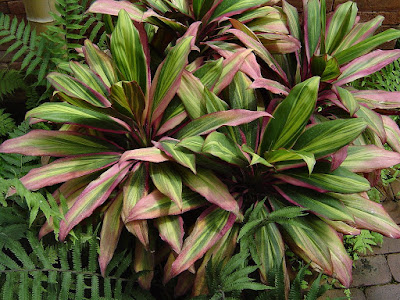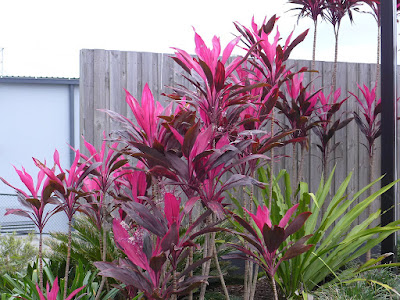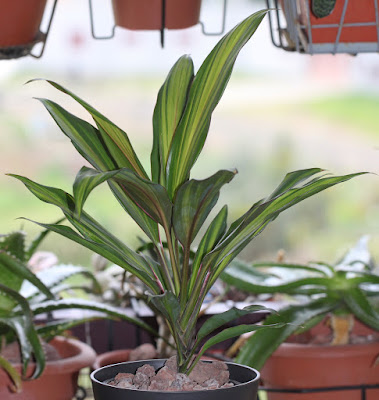Cordyline fruticosa - Ti plant does well between 18 and 35 ˚C and is hardy to about 0 ˚C. It grows well in USDA Zone 8-10, but can also grow in 3-7...
Cordyline fruticosa, also called as Ti plant, Palm lily, Cabbage palm, Good-luck plant, Miracle plant, Dracaena palm, Convallaria fruticosa, Asparagus terminalis, Cordyline terminalis, Dracaena terminalis, Terminalis fruticosa, is a species of the genus Cordyline. This species was described by Auguste Jean Baptiste Chevalier in 1919.
IDENTIFY CORDYLINE FRUTICOSA - TI PLANT
Cordyline fruticosa is found throughout tropical Asia, Australia, and
the Pacific islands. It commonly grows in moist, semi-shaded areas in wet
valleys and forests. It is the most popular Cordyline species as an
indoor potted plant and is used extensively by florists as cut green foliage
for flower arrangements and decorative displays.
It is an upright evergreen shrub with slender single or branched stems, growing up to 10 feet high. Leaf clusters are arranged in close spirals at the branch tips. The leaves are 1-2 feet long and about 4 inches wide, some varieties have very small leaves, only 8 inches long and 2 inches wide. Foliage may be green or variegated with various combinations of red, pink, purple, maroon, rose, yellow, and orange.
Ti plant blooms in spring from the 16-24 inches long panicles. The scented flowers come in several colors as white, pink, lavender, or yellow and mature into berries. The fruit cover is fleshy and may be green, yellow, red, or scarlet. Some cultivars have red flowers and large scarlet berries.
Plants grown from seed have provided hundreds of cultivars, displaying a wide range of plant size, leaf size, shape, and color including purple, crimson, scarlet, rust, pink and green; or striped with pink, red, and white. These cultivars are then propagated vegetatively. Various growing conditions often alter leaf color.
CORDYLINE FRUTICOSA - TI PLANT CARE AND CULTURE
Cultural information should only be used as a guide, and should be to be adapted to suit you. Your physical location; where you grow your plants, how much time you have to devote to their care, and many other factors, will need to be taken into account. Only then can you decide on the cultural methods that best suit you and your plants.
Light:
Cordyline fruticosa can be grown outdoors in full sun or under shade cloth. It is best grown in light to moderate shade (3000-4500 foot-candles). Leaf coloration is more striking in sunnier locations, although the foliage of brightly colored cultivars and those with white-striped leaves is easily burned when grown in full sunlight.
When grown indoor, the plants can tolerate light levels as low as 75-150 foot-candles. However, at those levels new growth becomes stretched and poor in color, and foliage variegation is reduced. Foliage color and quality retention improve as light increases to around 800 foot-candles. They develops its best leaf color in bright light and is less suitable for locations where it receives only artificial light. Plants require 4 hours of direct sunlight or bright, indirect light. Low light, low humidity, and hot, dry air can cause leaf loss.
Temperature:
Ti plant does well between 18 and 35 ˚C and is hardy to about 0 ˚C. It grows well in USDA Zone 8-10, but can also grow in USDA Zone 3-7 if you can protect the plants from winter damage. Leaf color is more intense during the cooler weather in the winter and spring. It prefers humidity levels between 40 and 60%. Avoid cold, drafty areas.
Substrate and growing media:
Cordyline fruticosa grow best in deep, fertile, moist, acidic, well drained soils that are high in organic matter. It can also grown in pot or containers (especially for USDA Zone 3-7 to protect the plants from winter damage) with a well-drained potting media containing high-quality peat at no more than 50-60%. Choose a medium with excellent aeration, good water-holding capacity, and good drainage characteristics. Soil pH should be 5.5 to 6.5. Use a 4-inch pot for a small plant or a 6-inch pot for a larger plant. Plants may be repotted into larger containers as they grow.
Apply a 2-4 inch layer of shredded bark, compost, leaves, straw or other organic matter around your plants to promote moisture retention, maintain even soil temperatures and discourage weed growth. Replenish the mulch as needed.
Watering:
Keep the well drained growth medium moist but not wet, avoiding extremes in wetness and dryness. Excessive drying between waterings causes tip burn and necrosis of the leaf margins. Infrequent, long soakings of water that thoroughly saturate the soil are more effective than frequent, light applications of water. During the first summer, you may need to water as often as every few days in periods of drought and extreme summer heat. To determine if your plant needs water, dig a few inches into the soil next to the plant. If the soil is dry 2-3 inches below the surface, it is time to water.
Overwatering can be as damaging as under watering. Be sure that the area surrounding your plant has adequate drainage to move water away from the plant. If you choose to plant in a container, always select one with drainage holes to prevent your plant's roots from sitting in water.
Fertilizer:
Ti plant can be top-dressed or incorporated into the potting medium with slow-release fertilizers. Apply a 20-10-20 fertilizer at a rate of 1 teaspoon in a 6-inch pot every 2 months. A liquid fertilizer may be used, applying a 20-10-20 fertilizer to provide 200 ppm N with every watering (or as recommended on the fertilizer container). Discontinue fertilize after September 1st to allow your plants to prepare for winter.
Pruning:
As the plant grows and produces new leaves at the tip, cut or pull off the lower leaves if they turn yellow or brown or become diseased with leaf spots. If any shoots become too tall or disproportionate, trim them as needed to achieve desired shape. Plants may be rejuvenated by cutting the stems back to 6 inches above the level of the soil or medium in the pot, so that new shoots will arise at a lower location on the stem.
© tanetahi
Winter period:
In USDA Zones 8-10, if freezing weather is expected, protect the roots by mounding a 6-8 inch layer of shredded bark, compost, leaves, straw or other organic material around the base of the plants. Potted plants should be moved into a protected area on exceptionally cold nights.
In USDA Zones 3-7, the plants should be grown in containers and moved indoors before the first frost. Select a room that is bright, preferably one with southern exposure. Indoors, plants tend to dry out from a lack of humidity. To boost the humidity level around your plant, fill a shallow tray with gravel and water then place the pot in the tray. The water level should be slightly below the gravel so that the pot is not submerged in water. As the water evaporates, it will create a more humid environment for your plant.
Watering should be reduced significantly while the plant is indoors. Do not overwater or allow your plant to sit in water. Remove any unsightly or dead growth over the winter to maintain an attractive appearance. In the spring when temperatures begin to rise, ease the plant into a full watering schedule and move it back outdoors for the summer.
Pests and diseases:
All varieties of cordyline can suffer from root rot if they remain too wet for too long. This can be avoided by ensuring drainage is good. Warm-climate varieties of cordyline may be attacked by grasshoppers, and cooler-climate varieties can be troubled by snails or slugs.
© alloe.
Propagation:
Cordyline fruticosa is usually propagated by stem cuttings. Cut stem sections in pieces 1 inch or more long. Cuttings from young stems are easier to root than those from old, woody stems. Cuttings root quickly, and a rooting hormone is not necessary. Plant cuttings vertically or horizontally into a rooting medium (perlite, vermiculite, or peat moss-sand mixture) so that three-fourths of the length of the vertical section is buried or 1/4 inch of the diameter of the horizontal section is covered. Cuttings inserted in a vertical position will grow into single plants. Cuttings inserted in a horizontal position may grow into several plants, depending on their length. Keep cuttings moist and in a partially shaded location. Mist can be applied manually, typically two or three times per day. Rooting time is 2-4 weeks. A terminal cluster of leaves with 6 inches of stem will root quickly and make a well-shaped plant in 4-6 months.
Cuttings may also be rooted in plain water and should be at least 6 inches long. The end of the cutting should be immersed in about 1 inch of water. Water in the container should be changed occasionally to prevent the growth of plant pathogens or rot organisms. A water-soluble fertilizer such as 20-10-20 may be added to the water to provide some nutrients (follow the directions on the fertilizer package). After a strong root system has developed, the cutting may be transplanted. The cuttings should be planted before the rootlets get very long; otherwise, they may break off in the planting process.



















COMMENTS